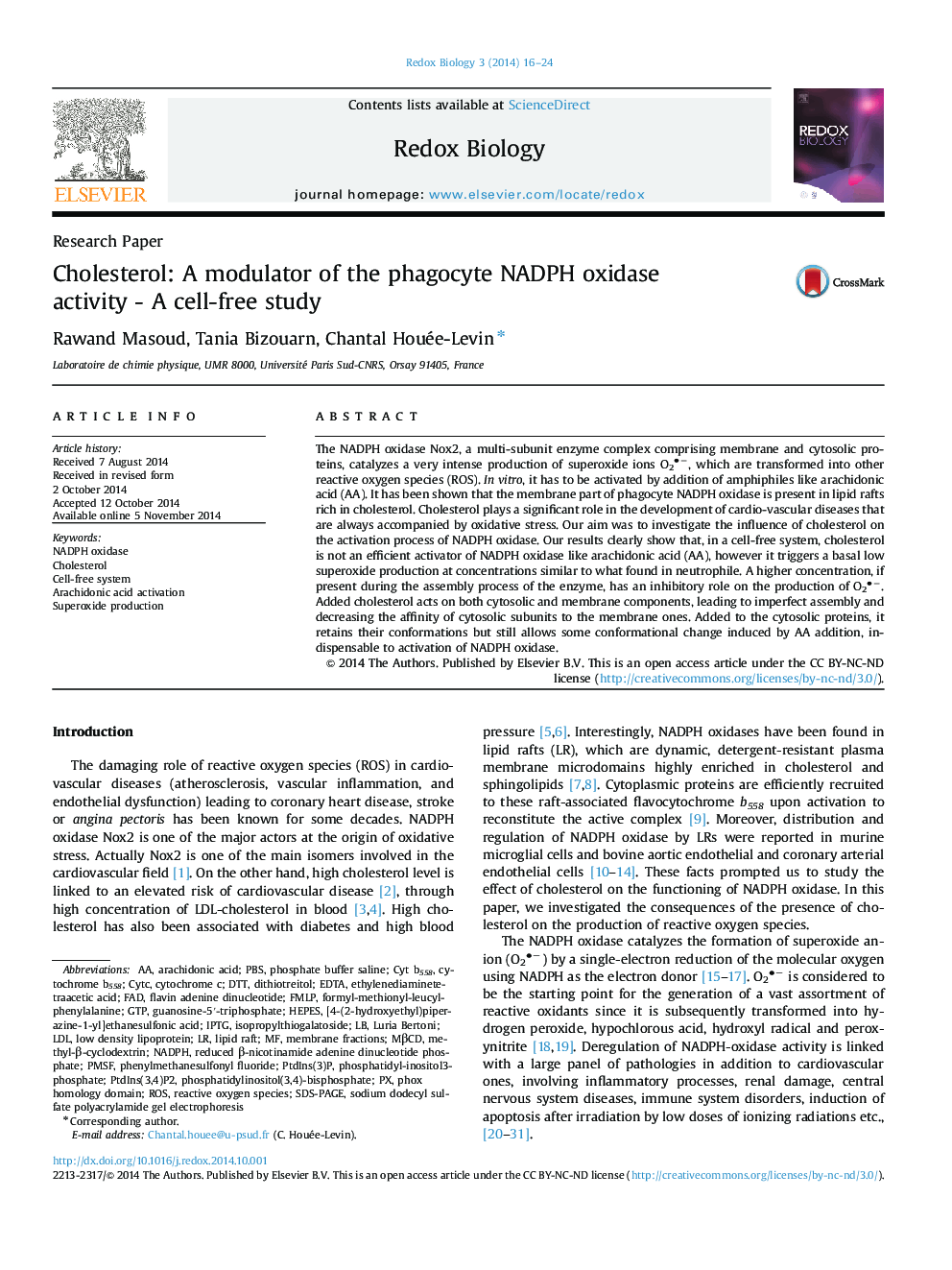| Article ID | Journal | Published Year | Pages | File Type |
|---|---|---|---|---|
| 1923114 | Redox Biology | 2014 | 9 Pages |
Abstract
The NADPH oxidase Nox2, a multi-subunit enzyme complex comprising membrane and cytosolic proteins, catalyzes a very intense production of superoxide ions O2
- â, which are transformed into other reactive oxygen species (ROS). In vitro, it has to be activated by addition of amphiphiles like arachidonic acid (AA). It has been shown that the membrane part of phagocyte NADPH oxidase is present in lipid rafts rich in cholesterol. Cholesterol plays a significant role in the development of cardio-vascular diseases that are always accompanied by oxidative stress. Our aim was to investigate the influence of cholesterol on the activation process of NADPH oxidase. Our results clearly show that, in a cell-free system, cholesterol is not an efficient activator of NADPH oxidase like arachidonic acid (AA), however it triggers a basal low superoxide production at concentrations similar to what found in neutrophile. A higher concentration, if present during the assembly process of the enzyme, has an inhibitory role on the production of O2
- â. Added cholesterol acts on both cytosolic and membrane components, leading to imperfect assembly and decreasing the affinity of cytosolic subunits to the membrane ones. Added to the cytosolic proteins, it retains their conformations but still allows some conformational change induced by AA addition, indispensable to activation of NADPH oxidase.
- â, which are transformed into other reactive oxygen species (ROS). In vitro, it has to be activated by addition of amphiphiles like arachidonic acid (AA). It has been shown that the membrane part of phagocyte NADPH oxidase is present in lipid rafts rich in cholesterol. Cholesterol plays a significant role in the development of cardio-vascular diseases that are always accompanied by oxidative stress. Our aim was to investigate the influence of cholesterol on the activation process of NADPH oxidase. Our results clearly show that, in a cell-free system, cholesterol is not an efficient activator of NADPH oxidase like arachidonic acid (AA), however it triggers a basal low superoxide production at concentrations similar to what found in neutrophile. A higher concentration, if present during the assembly process of the enzyme, has an inhibitory role on the production of O2
- â. Added cholesterol acts on both cytosolic and membrane components, leading to imperfect assembly and decreasing the affinity of cytosolic subunits to the membrane ones. Added to the cytosolic proteins, it retains their conformations but still allows some conformational change induced by AA addition, indispensable to activation of NADPH oxidase.
Keywords
PMSFPtdIns(3)Pmembrane fractionsPhox homology domainPtdIns(3,4)P2Cytochrome b558dithiotreitolfMLPCytCMβCDNADPHDTTIPTGPBSGTPHEPESflavin adenine dinucleotideguanosine-5′-triphosphateROSEDTAEthylenediaminetetraacetic acidArachidonic acidSDS-PAGESodium dodecyl sulfate polyacrylamide gel electrophoresisNADPH oxidaseFADSuperoxide productioncytochrome cCell-free systemFormyl-methionyl-leucyl-phenylalaninephosphate buffer salinePhenylmethanesulfonyl fluorideLipid raftlow density lipoproteinLDLmethyl-β-cyclodextrinreduced β-nicotinamide adenine dinucleotide phosphatecholesterolReactive oxygen species
Related Topics
Life Sciences
Biochemistry, Genetics and Molecular Biology
Ageing
Authors
Rawand Masoud, Tania Bizouarn, Chantal Houée-Levin,
